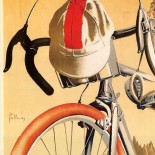Cycling Shorts: The Peace Race, 1974
This photograph of the West German cycling team was taken on the Karl Marx Allee, East Berlin’s monumental socialist boulevard, during the 1975 edition of the Peace Race. It captures a moment in the history of Europe and of cycling that is now many years past. A time when the continent was split along ideological fault-lines that emphasised the differences between East and West rather than recognizing the similarities.
The Peace Race, also known as the Friedensfahrt (German), Závod míru (Czech), and Wyścig Pokoj (Polish) was first run as a double edition between Warsaw-Prague and Prague-Warsaw in 1948. Like its better known Western European counterpart, Le Tour, the Peace Race was an annual multi-stage bicycle race. Unlike Le Tour, the Peace Race was strictly for amateur sportsmen in the non-professional world of sport in the Eastern Bloc. Like Le Tour, the Peace Race was sponsored by the news media, in this case by the official Communist Party newspapers of its host countries, Czechoslovakia’s Rudé právo, East Germany’s Neues Deutschland and Poland’s Trybuna Ludu.
For most of its existence the Peace Race featured a route that took in Warsaw, Berlin, and Prague and in 1974 the route visited these cities in this order, covering 1,823 kilometres in 14 stages. Teams from Poland, Great Britain, Belgium, Czechoslovakia, Bulgaria, the Soviet Union, Hungary, Austria, Denmark, East Germany, Italy, Romania, Yugoslavia, Cuba, France, the Netherlands, Finland, and West Germany lined up to complete the first stage, a 20 kilometre long individual time trial from Jabłonna to Nowy Dwór, with Tadeusz Mytnik (Poland) winning in a time of 29 minutes, 38 seconds.
Victory on stage 1 was to set the tone of the race which saw the Polish team, and their rider Stanisław Szozda dominate the race. In a remarkable display of consistency Szozda placed in the top ten in thirteen of the fourteen stages, winning six stages in total that included a record-breaking four in a row on stages nine to twelve and the final stage in Prague. His overall winning margin over second placed Nikolai Gorelov of the USSR was 3 minutes, 4 seconds. Poland won the team competition with an accumulative time of 127 hours, 5 minutes, and 5 seconds. The Dutchman, Theo Smit, won the most active rider award for accumulating the most points in sprints, climbs, and attacks. The green climber’s jersey went to Gorelov.
The Peace Race has now been consigned to the pages of history, a casualty of the demise of communism and the withdrawal of state funding. After finally running its last full edition in 2006 it now lives on as a three day race for under 23’s held in May in the Czech Republic. In its heyday the Peace Race was the biggest amateur cycle race in the world and the closest thing the Eastern Bloc world had to Le Tour. In a sense it was even bigger, carrying with it, as it did, the notions of socialist prestige on an international stage and by being the vehicle of an ideology that sought to shape the way society thought and acted. I leave the final words to Horst Schäfer, curator of the Freidensfahrt Museum:
The Peace Race was an oasis, and through it we were able to dream. It was about different peoples, from different countries, crossing borders and coming together. It was about genuine fellowship, and that was its beauty and virtue. For two weeks a year it offered us a window on worlds we were denied access to. It was a huge paradox, but for me it remains something beautiful. It was the race of peace.
____
Horst Schäfer is quoted in Herbie Sykes, The Race Against the Stasi: The Incredible Story of Dieter Wiedemann, the Iron Curtain and the Greatest Cycling Race on Earth (London: Aurum Press, 2014), ix.




The first picture shows the *West* German team and is dated from 1975!
43 – Herbert Brehm
44 – Michael Schultz
45 – Volker Kassun
46 – Olaf Paltian
47 – Wilfried Trott
48 – Peter Weibel
LikeLike
Dirk, thanks for the clarification. I’ve amended the article to reflect this.
LikeLike